The Biomaterial In Surgical Mesh Market is estimated to be valued at USD 2.4 billion in 2025 and is projected to reach USD 5.0 billion by 2035, registering a compound annual growth rate (CAGR) of 7.5% over the forecast period.
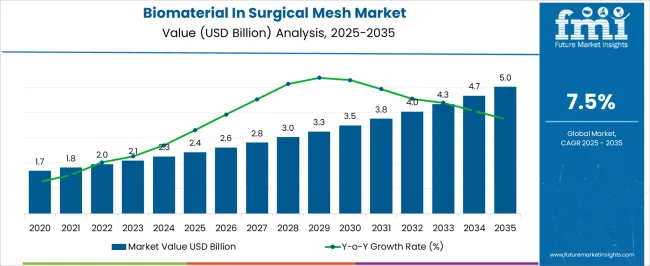
| Metric | Value |
|---|---|
| Biomaterial In Surgical Mesh Market Estimated Value in (2025 E) | USD 2.4 billion |
| Biomaterial In Surgical Mesh Market Forecast Value in (2035 F) | USD 5.0 billion |
| Forecast CAGR (2025 to 2035) | 7.5% |
The Biomaterial In Surgical Mesh market is experiencing significant growth, driven by the rising demand for advanced surgical interventions and implantable materials that enhance patient outcomes. Increasing incidences of cardiovascular, hernia, and other soft tissue disorders are creating a strong need for biocompatible and durable mesh solutions. Adoption is being supported by advancements in biomaterials, including metallic, polymeric, and composite meshes, which offer superior mechanical strength, flexibility, and tissue integration.
Hospitals and surgical centers are increasingly prioritizing materials that reduce postoperative complications, infection rates, and recovery time. The integration of innovative coatings and surface treatments in surgical meshes has improved biocompatibility and reduced risks associated with immune response and tissue rejection. Regulatory approvals and clinical validations are further boosting confidence among surgeons and healthcare providers.
As healthcare infrastructure expands and minimally invasive procedures become more common, the market is positioned for long-term growth Continuous research and development, coupled with increasing awareness among healthcare professionals, are expected to drive adoption and strengthen market dynamics in the coming years.
The biomaterial in surgical mesh market is segmented by type of material, application, end user, and geographic regions. By type of material, biomaterial in surgical mesh market is divided into Metallic, Polymeric, and Natural Biomaterials. In terms of application, biomaterial in surgical mesh market is classified into Cardiovascular, Dental, Orthopedic, Wound Healing, Plastic Surgery, Ophthalmology, Tissue Engineering, Neurological Disorders, and Drug-Delivery Systems. Based on end user, biomaterial in surgical mesh market is segmented into Hospitals, Ambulatory Surgical Centers, Diagnostic Centers, and Clinics. Regionally, the biomaterial in surgical mesh industry is classified into North America, Latin America, Western Europe, Eastern Europe, Balkan & Baltic Countries, Russia & Belarus, Central Asia, East Asia, South Asia & Pacific, and the Middle East & Africa.
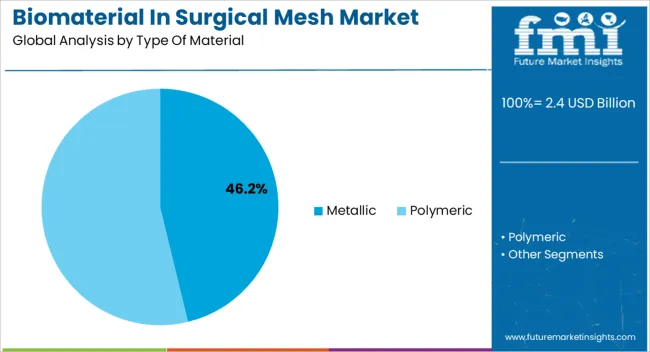
The metallic material segment is projected to hold 46.2% of the market revenue in 2025, establishing it as the leading material type. Its growth is driven by the superior strength, durability, and stability that metallic surgical meshes provide, particularly for high-load applications such as cardiovascular and hernia repairs. Metallic meshes offer excellent tissue support, long-term structural integrity, and reduced risk of mesh deformation, which are critical for successful surgical outcomes.
Advanced manufacturing techniques, including precision weaving and coating technologies, have improved biocompatibility and reduced postoperative complications. Hospitals and surgical centers favor metallic meshes due to their predictable performance, reliability, and long-term efficacy.
The ability to combine metallic meshes with coatings and hybrid biomaterials allows for customization to meet patient-specific needs As the demand for durable and high-performance implantable meshes rises globally, the metallic material segment is expected to maintain its leadership, supported by continuous innovation, clinical adoption, and improvements in surgical techniques that enhance patient safety and outcomes.
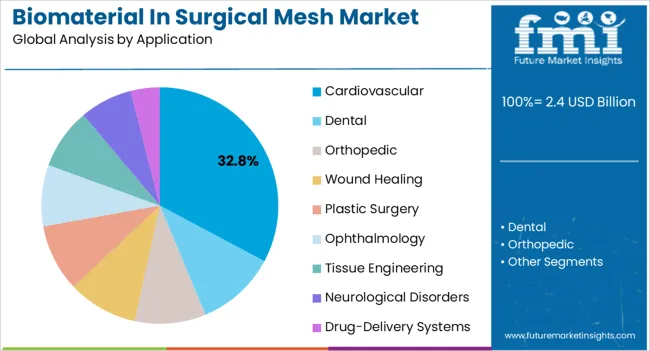
The cardiovascular application segment is anticipated to account for 32.8% of the market revenue in 2025, making it the leading application area. Its growth is driven by the increasing prevalence of cardiovascular diseases and the need for advanced implantable devices that support vascular repair and replacement. Surgical meshes in cardiovascular applications provide structural support, facilitate tissue integration, and enhance the long-term functionality of grafts and implants.
Innovations in biomaterial composition, including metallic alloys and hybrid materials, have improved mechanical strength, flexibility, and biocompatibility, which are critical for cardiovascular surgeries. Hospitals and specialized cardiac centers are adopting surgical meshes to reduce complications, improve patient outcomes, and optimize procedural efficiency.
The ability to customize mesh properties according to patient anatomy and disease severity further supports adoption With ongoing research in minimally invasive cardiovascular procedures and biomaterial engineering, the cardiovascular segment is expected to remain a primary driver of market growth, ensuring continued demand for high-performance surgical meshes.
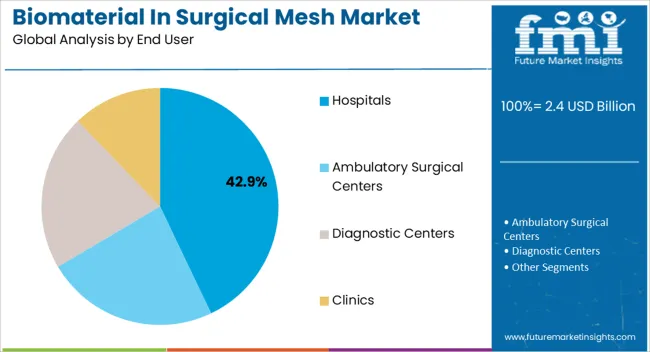
The hospital end user segment is projected to hold 42.9% of the market revenue in 2025, establishing it as the leading end-use category. Growth is being driven by the high volume of surgical procedures, availability of advanced surgical infrastructure, and the critical role hospitals play in implementing complex interventions requiring surgical meshes. Hospitals benefit from standardized procurement processes, trained surgical teams, and the ability to adopt advanced biomaterials that enhance patient safety and recovery.
Integration of surgical mesh solutions into hospital workflows allows for improved procedural efficiency, reduced complication rates, and better post-surgical outcomes. Increasing adoption of minimally invasive and robotic-assisted surgeries further reinforces demand for reliable and high-quality meshes.
Hospitals are also influenced by regulatory compliance, clinical evidence, and cost-effectiveness when selecting biomaterials As healthcare facilities continue to expand capacity and adopt innovative surgical technologies, the hospital segment is expected to remain the dominant end user, driving sustained market growth and shaping the future landscape for biomaterial-based surgical meshes.
Biomaterials is an organic or artificial material which can be introduced into body tissue as part of a implantable medical device or it can also be used to replace an organ etc. They can be obtained naturally or by a synthetic process in the laboratories.
These are used in a various medical application, as in biomaterials are implanted in the human body to replace or repair the damaged tissues. There are different types of biomaterials, such as bone substitutes and collagen membranes, are used frequently in recreating dentistry as well as for bone and cartilage restoration in orthopedics.
Biomaterials are usually found in the virtually instruments, devices, and implants and or in a piece of equipment in the surgery room. These biomaterials is much useful for the surgeons as an influential clinical tool in treating a patient undergoing with various disorders or treatment.
Since long the physicians and the surgeons have factually determined for a clinical usage of biomaterials and stand tall in contributing the ongoing development of biomaterials. Having a basic understanding of the ingredients/materials available and their basic properties can subsidize to better and more effective outcomes.
An outline to the four different material classified are metals, polymers, ceramics, and composites. Wider approach like usage in nanotechnology and tissue engineering also briefly define expansion within the field.
The progress of treatments for specified pectus excavatum and congenital diaphragmatic hernias are described because the biomaterial are much used in the combination of surgical mesh with biomaterials, highlighting the role of biomaterials.
The global leaders (companies) in the field of biomaterial in surgical mesh are funding significantly through new product launch, research and development, novelty, partnership and alliance. Research and development is measured to be the key step to deep dive into biomaterial with surgical mesh market and to originate innovative products. Research and development in biomaterial is increasing the market growth of biomaterial in surgical mesh.
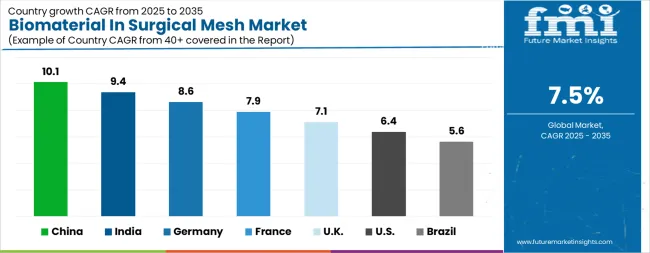
| Country | CAGR |
|---|---|
| China | 10.1% |
| India | 9.4% |
| Germany | 8.6% |
| France | 7.9% |
| UK | 7.1% |
| USA | 6.4% |
| Brazil | 5.6% |
The Biomaterial In Surgical Mesh Market is expected to register a CAGR of 7.5% during the forecast period, exhibiting varied country level momentum. China leads with the highest CAGR of 10.1%, followed by India at 9.4%. Developed markets such as Germany, France, and the UK continue to expand steadily, while the USA is likely to grow at consistent rates. Brazil posts the lowest CAGR at 5.6%, yet still underscores a broadly positive trajectory for the global Biomaterial In Surgical Mesh Market. In 2024, Germany held a dominant revenue in the Western Europe market and is expected to grow with a CAGR of 8.6%. The USA Biomaterial In Surgical Mesh Market is estimated to be valued at USD 880.9 million in 2025 and is anticipated to reach a valuation of USD 1.6 billion by 2035. Sales are projected to rise at a CAGR of 6.4% over the forecast period between 2025 and 2035. While Japan and South Korea markets are estimated to be valued at USD 131.5 million and USD 74.1 million respectively in 2025.
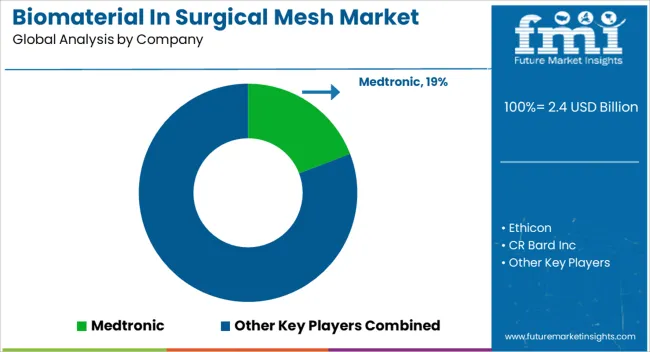
| Item | Value |
|---|---|
| Quantitative Units | USD 2.4 Billion |
| Type Of Material | Metallic, Polymeric, and Natural Biomaterials |
| Application | Cardiovascular, Dental, Orthopedic, Wound Healing, Plastic Surgery, Ophthalmology, Tissue Engineering, Neurological Disorders, and Drug-Delivery Systems |
| End User | Hospitals, Ambulatory Surgical Centers, Diagnostic Centers, and Clinics |
| Regions Covered | North America, Europe, Asia-Pacific, Latin America, Middle East & Africa |
| Country Covered | United States, Canada, Germany, France, United Kingdom, China, Japan, India, Brazil, South Africa |
| Key Companies Profiled | Medtronic, Ethicon, CR Bard Inc, Atrium WL, Gore & Associates, LifeCell Corporation, B. Braun Melsungen AG, Cook Medical Inc, and MTF Biologics |
The global biomaterial in surgical mesh market is estimated to be valued at USD 2.4 billion in 2025.
The market size for the biomaterial in surgical mesh market is projected to reach USD 5.0 billion by 2035.
The biomaterial in surgical mesh market is expected to grow at a 7.5% CAGR between 2025 and 2035.
The key product types in biomaterial in surgical mesh market are metallic, _stainless steel, _titanium & titanium alloys, _cobalt-chrome alloys, _silver, _ceramic, _calcium phosphate, _aluminium oxide, _zirconia, _others, polymeric, _polymethylmethacrylate (pmma), _polyethylene, _polyester, _polyvinyl chloride, natural biomaterials, _hyaluronic acid, _collagen, _gelatin and _fibrin.
In terms of application, cardiovascular segment to command 32.8% share in the biomaterial in surgical mesh market in 2025.






Our Research Products

The "Full Research Suite" delivers actionable market intel, deep dives on markets or technologies, so clients act faster, cut risk, and unlock growth.

The Leaderboard benchmarks and ranks top vendors, classifying them as Established Leaders, Leading Challengers, or Disruptors & Challengers.

Locates where complements amplify value and substitutes erode it, forecasting net impact by horizon

We deliver granular, decision-grade intel: market sizing, 5-year forecasts, pricing, adoption, usage, revenue, and operational KPIs—plus competitor tracking, regulation, and value chains—across 60 countries broadly.

Spot the shifts before they hit your P&L. We track inflection points, adoption curves, pricing moves, and ecosystem plays to show where demand is heading, why it is changing, and what to do next across high-growth markets and disruptive tech

Real-time reads of user behavior. We track shifting priorities, perceptions of today’s and next-gen services, and provider experience, then pace how fast tech moves from trial to adoption, blending buyer, consumer, and channel inputs with social signals (#WhySwitch, #UX).

Partner with our analyst team to build a custom report designed around your business priorities. From analysing market trends to assessing competitors or crafting bespoke datasets, we tailor insights to your needs.
Supplier Intelligence
Discovery & Profiling
Capacity & Footprint
Performance & Risk
Compliance & Governance
Commercial Readiness
Who Supplies Whom
Scorecards & Shortlists
Playbooks & Docs
Category Intelligence
Definition & Scope
Demand & Use Cases
Cost Drivers
Market Structure
Supply Chain Map
Trade & Policy
Operating Norms
Deliverables
Buyer Intelligence
Account Basics
Spend & Scope
Procurement Model
Vendor Requirements
Terms & Policies
Entry Strategy
Pain Points & Triggers
Outputs
Pricing Analysis
Benchmarks
Trends
Should-Cost
Indexation
Landed Cost
Commercial Terms
Deliverables
Brand Analysis
Positioning & Value Prop
Share & Presence
Customer Evidence
Go-to-Market
Digital & Reputation
Compliance & Trust
KPIs & Gaps
Outputs
Full Research Suite comprises of:
Market outlook & trends analysis
Interviews & case studies
Strategic recommendations
Vendor profiles & capabilities analysis
5-year forecasts
8 regions and 60+ country-level data splits
Market segment data splits
12 months of continuous data updates
DELIVERED AS:
PDF EXCEL ONLINE
Minor Surgical Lights Market
Surgical Instruments Tracking System Market Growth - Trends & Forecast 2025 to 2035
Surgical Instruments Packaging Market Size, Share & Forecast 2025 to 2035
Surgical Mesh Market
Surgical Drainage Devices Market Size and Share Forecast Outlook 2025 to 2035
Mesh Tarpaulin Sheets Market Size and Share Forecast Outlook 2025 to 2035
Surgical Sphincteroplasty Market Analysis – Trends & Industry Outlook 2024-2034
Surgical Retainers Market
Surgical Stapling Device Market is segmented by product, Usage Type, Stapling Type, Indication and End User from 2025 to 2035
Surgical Site Infections Market
Surgical Operating Microscope Market Forecast and Outlook 2025 to 2035
3D Printed Surgical Models Market Analysis - Size, Share, and Forecast 2025 to 2035
Non-invasive Surgical Wound Closure Market Analysis - Size, Share, and Forecast 2025 to 2035
Surgical Suction Instruments Market
3D Imaging Surgical Solution Market Size and Share Forecast Outlook 2025 to 2035
Surgical Polypropylene Mesh Market
Screen Printing Mesh Market Size and Share Forecast Outlook 2025 to 2035
Hospital Surgical Disinfectant Market Size and Share Forecast Outlook 2025 to 2035
Demand for Biomaterial in USA Size and Share Forecast Outlook 2025 to 2035
Demand for Biomaterial in Japan Size and Share Forecast Outlook 2025 to 2035

Thank you!
You will receive an email from our Business Development Manager. Please be sure to check your SPAM/JUNK folder too.
Chat With
MaRIA